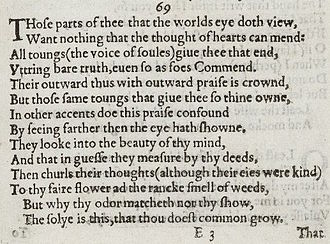Sonnet 69
Q1
Q2
Q3
C
Those parts of thee that the world’s eye doth view
Want nothing that the thought of hearts can mend;
All tongues, the voice of souls, give thee that due,
Uttering bare truth, even so as foes commend.
Thy outward thus with outward praise is crown’d;
But those same tongues, that give thee so thine own,
In other accents do this praise confound
By seeing farther than the eye hath shown.
They look into the beauty of thy mind,
And that, in guess, they measure by thy deeds;
Then churls, their thoughts, although their eyes were kind,
To thy fair flower add the rank smell of weeds:
But why thy odour matcheth not thy show,
The soil is this, that thou dost common grow.
4
8
12
14
Shakespeare's Sonnet 69, like many of those nearby in the sequence, expresses extremes of feelings about the beloved subject, who is presented as at once superlative in every way and treacherous or disloyal.
What the world can see of you is perfect; no one denies you that name of perfection. Everyone admits this without hesitation or limitation. But the same people who so readily praise your beauty reverse that praise when they examine you in other ways. These people, judging your mind and character by your actions, decide that you are as much foul as beautiful. And the reason that your odor does not match your appearance is you have become common (i.e. keep company that befouls your reputation.)
Sonnet 69 is an English or Shakespearean sonnet. The English sonnet has three quatrains, followed by a final rhyming couplet. It follows the typical rhyme scheme of the form, abab cdcd efef gg and is composed in iambic pentameter, a type of poetic metre based on five pairs of metrically weak/strong syllabic positions. The fifth line exemplifies a regular iambic pentameter:
The twelfth line is open to several alternative scansions. It may exhibit two instances of the rightward movement of an ictus (the resulting four-position figure, × × / /, is sometimes referred to as a minor ionic):
(This figure can also be found in the first line.) Alternatively, the line could be scanned with one minor ionic followed by a mid-line reversal (replacing × / with / ×):
...
Wikipedia

